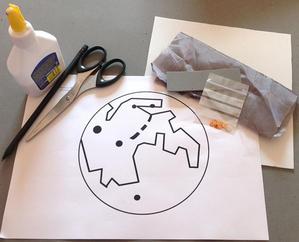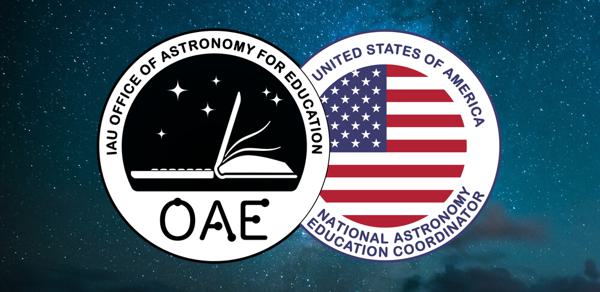Glossary term: Moon
Description: The Moon is a celestial body that is not luminous on its own, but reflects the sunlight falling on it. This produces the Moon's characteristic phases. The Moon is the only major natural satellite of Earth, and ranks fifth among the natural satellites of the Solar System in terms of size and mass. "Moon" is capitalized to distinguish it from other natural satellites, or moons, in the Solar System and beyond. Compared with other Solar System moons, the Moon has the largest size relative to the size of the planet it orbits. The Moon follows an elliptical orbit around Earth, at an average distance from Earth of 384,000 kilometers (km). It has no atmosphere and is composed of similar materials to the Earth with an iron-rich core and rocky outer layers. The similarity is no accident: To the best of our knowledge, the Moon formed from the debris of the collision between Earth and a Mars-sized planet around 4.5 billion years ago; most of its material stems from the original Earth's mantle. The surface of the Moon has dark areas known as mare, lighter highlands, and is pockmarked with craters. The surface area of the Moon is 3.79 x 107 square kilometers, its volume is 2.20 x 1010 cubic kilometers, and its mass is 7.35 x 1022 kilograms (kg). The exact value of the Moon's orbital period around Earth depends on the frame of reference: relative to the distant stars, it completes one orbit every 27.3 days ("sidereal period"). For an observer on Earth, the time between two new moons is 29.5 days ("synodic period").
Related Terms:
See this term in other languages
Term and definition status: This term and its definition have been approved by a research astronomer and a teacher
The OAE Multilingual Glossary is a project of the IAU Office of Astronomy for Education (OAE) in collaboration with the IAU Office of Astronomy Outreach (OAO). The terms and definitions were chosen, written and reviewed by a collective effort from the OAE, the OAE Centers and Nodes, the OAE National Astronomy Education Coordinators (NAECs) and other volunteers. You can find a full list of credits here. All glossary terms and their definitions are released under a Creative Commons CC BY-4.0 license and should be credited to "IAU OAE".
If you notice a factual error in this glossary definition then please get in touch.
Related Media
Apollo 11 lunar activity
Credit: NASA/Project Apollo Archive credit link
License: PD Public Domain icons
Selene meets the Moon, by Sheila Wiwchar, Canada
Credit: Sheila Wiwchar/IAU OAE
License: CC-BY-4.0 Creative Commons Attribution 4.0 International (CC BY 4.0) icons
Red Moon, by Daniel Henrion, France
Credit: Daniel Henrion/IAU OAE
License: CC-BY-4.0 Creative Commons Attribution 4.0 International (CC BY 4.0) icons
The eclipsed Moon sets near the Rochetta di Prendera, Dolomiti Unesco, by Alessandra Masi, Italy
Credit: Alessandra Masi/IAU OAE
License: CC-BY-4.0 Creative Commons Attribution 4.0 International (CC BY 4.0) icons
Full moon
Credit: Luc Viatour credit link
License: CC-BY-SA-3.0 Creative Commons Attribution-ShareAlike 3.0 Unported icons
Related Activities
Lunar Landscape
astroEDU educational activity (links to astroEDU website) Description: Create craters and explore the lunar landscape with this hands-on activity.
License: CC-BY-4.0 Creative Commons Attribution 4.0 International (CC BY 4.0) icons
Tags:
Hands-on
, Model
, Lunar landscape
, Craters
Age Ranges:
4-6
, 6-8
, 8-10
Education Level:
Primary
Areas of Learning:
Modelling
Costs:
Medium Cost
Group Size:
Group
Skills:
Asking questions
, Communicating information
, Developing and using models
Meet Our Neighbours: Moon
astroEDU educational activity (links to astroEDU website) Description: Explore the tactile version of our moon with household materials.
License: CC-BY-4.0 Creative Commons Attribution 4.0 International (CC BY 4.0) icons
Tags:
Hands-on
, Model
, Visually Impaired
, Tactile
Age Ranges:
6-8
, 8-10
, 10-12
Education Level:
Middle School
, Primary
, Secondary
Areas of Learning:
Interactive Lecture
, Modelling
Costs:
Low Cost
Group Size:
Group
Skills:
Analysing and interpreting data
, Asking questions
, Communicating information
, Developing and using models
Lunar Day
astroEDU educational activity (links to astroEDU website) Description: Through a fun-learning activity, understand why moon always keeps the same face towards Earth.
License: CC-BY-4.0 Creative Commons Attribution 4.0 International (CC BY 4.0) icons
Tags:
Lunar day
Age Ranges:
4-6
, 6-8
Education Level:
Primary
, Secondary
Areas of Learning:
Modelling
, Structured-inquiry learning
Costs:
Free
Duration:
30 mins
Group Size:
Group
Skills:
Analysing and interpreting data
, Asking questions
, Communicating information
, Constructing explanations
, Developing and using models
Sun, Earth and Moon Model
astroEDU educational activity (links to astroEDU website) Description: Build an Earth-Moon-Sun mobile to learn about how they orbit.
License: CC-BY-4.0 Creative Commons Attribution 4.0 International (CC BY 4.0) icons
Tags:
Hands-on
, Model
Age Ranges:
8-10
Education Level:
Primary
Areas of Learning:
Game-mediated learning
, Modelling
, Social Research
Costs:
Medium Cost
Duration:
1 hour 30 mins
Group Size:
Group
Skills:
Asking questions
, Communicating information
, Developing and using models
Children's Planetary Maps: The Moon
astroEDU educational activity (links to astroEDU website) Description: An up close look at our own satellite
License: CC-BY-4.0 Creative Commons Attribution 4.0 International (CC BY 4.0) icons
Tags:
Maps
, Planetary cartography
, Spatial thinking
Age Ranges:
6-8
, 8-10
, 10-12
, 12-14
Education Level:
Middle School
, Primary
, Secondary
Areas of Learning:
Social Research
Costs:
Low Cost
Duration:
2 hours
Group Size:
Group
Skills:
Analysing and interpreting data
, Asking questions
, Communicating information
, Constructing explanations
, Developing and using models
, Engaging in argument from evidence
, Planning and carrying out investigations


















